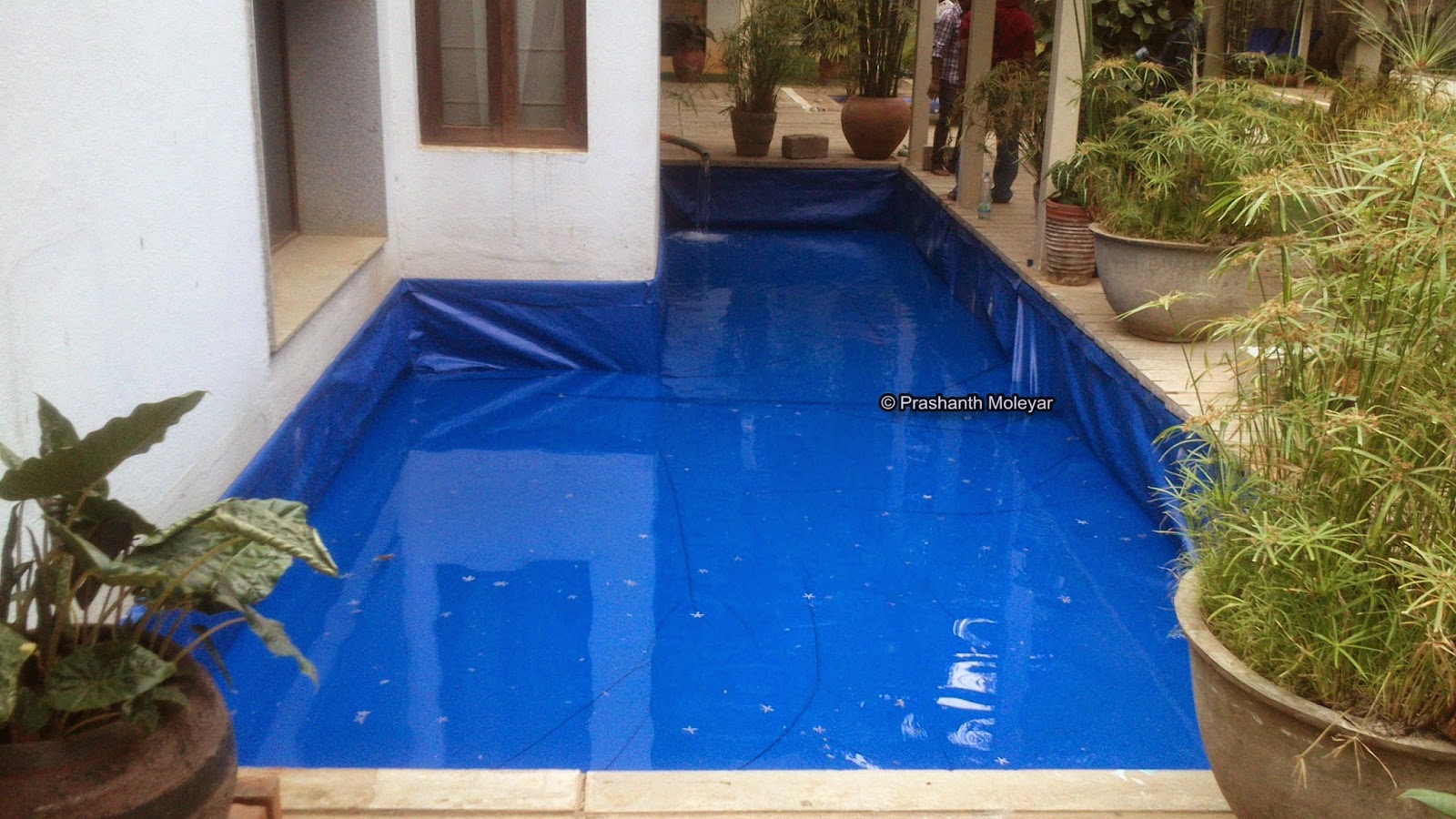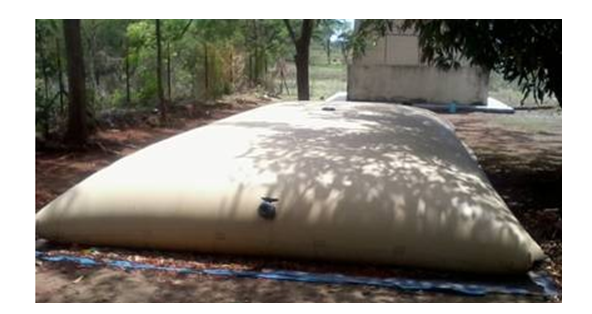What is HDPE Geomembrane?
Laminated high density polyethylene woven fabric,
so called geo-membranes, are very low permeability synthetic liners used to
control fluid or gas migration within soil, rock, earth or any other
geotechnical material, as integral part of a manmade product, structure or
system. As a synthetic component used within the ground, they are technically
geo-synthetic, the prefix ‘geo’ indicating usage on or in the earth. The other
primary geo-synthetics are geo-textiles, geo-nets, geo-grids, geo-composites
and geo-composite clay liners.
The original use of geo-membranes was for the distribution, storage and containment of potable agricultural water supplies. It still remains as an important element of this market, except now it has been broadened to contain a wide variety of liquids.
Geo-membranes have become the design choice as part of a cover system due to a variety of factors such as imperviousness, chemical resistance, inertness to surrounding soils, ease and variety of seaming, mechanical strength and elongation, ease of application and economics, product durability and ageing over the designed life of the containment system.
GUIDELINES FOR INSTALLATION OF HDPE
GEOMEMBRANE
1 The Primary
function of geo-membrane applied in ponds/reservoirs is to prevent loss of water
due to seepage. The successful performance of geo-membrane is based on a good
quality material, installation and appropriate design of ponds/reservoirs.
2 To improve
the service lifetime of geo-membrane, it is essential that the geo-membrane are
placed on the pond/reservoir surface according to the dimensions and contours
of the pond/reservoir ensuring full contact with the sub grade. To achieve this
onsite laying, joining and fixing is imperative.
LOGISTICS
Geo-membrane are packed and transported by
appropriate means to protect the geomembrane and avoid any type of damage.
Rolls of geo-membrane are loaded manually/with a crane
and tie beam and can be unloaded in a similar manner at the destination. Use of
hooks shall be avoided for loading and unloading of the geo-membrane at site.
STORAGE AT SITE
1 The
geo-membrane shall be stored so as to be protected from puncture, dirt, grease,
water,
moisture, mud, mechanical abrasions, excessive heat or other damage. The rolls shall be stored on a prepared surface and to be stacked not more than three rolls.
moisture, mud, mechanical abrasions, excessive heat or other damage. The rolls shall be stored on a prepared surface and to be stacked not more than three rolls.
2 The owner
of the site where the geo-membrane is to be installed shall provide storage space
in a location sufficiently near the sub grade to be lined to minimize any
additional handling.
3 The storage
area shall be protected from theft, vandalism, vehicular traffic and any other source
which could create potential damage to the liner.
EARTHWORK AND SITE PREPARATION
Site Considerations
1 The site
selected for pond/reservoir shall not be within the path so that, it obstructs the
flow of the natural course of the water, rain fed Nallah or a stream as well as
in the pathway of concentrated surface runoff from the hills or elevated
grounds upstream of the pond/reservoir, as there are chances of underground
seepage of water into the pond/reservoir and geo-membrane is subjected to
upliftment.
2 The
proposed pond/reservoir site shall not be natural pit, a well or stone mines.
3 The
selected site shall be free from hard rocks/Murrum, a natural water source;
mountain etc.
4 The proposed site shall be free of any decomposable organic materials/vegetation as it can result in upliftment due to generation of gases beneath the geo-membrane.
4 The proposed site shall be free of any decomposable organic materials/vegetation as it can result in upliftment due to generation of gases beneath the geo-membrane.
Design and Sub grade Preparation
1 The
excavation of the pond/reservoir shall be done by means of a JCB or Pock Lain Machine.
2 The slope to bed ratio (V: H) shall be 1:1.5 minimum.
3 The embankments constructed shall be stable, as the unstable embankments will
collapse resulting into tensile or tear failure of geo-membrane.
4 The top width of the embankment shall be at least 1.5 meter wide.
5 Sub grade surface shall be levelled and made free of undesirable angular and sharp fragments, foreign and organic matter, stones and pebbles, as the presence may lead to cause pinholes and or puncture the geo-membrane.
6 Soil sterilization may be necessary to kill roots certain types of grasses by using an
effective sterilant/chemical, however the sterilant or the chemical used shall not be detrimental to the liner and shall be applied in accordance with the geo-membrane manufacturer’s recommendations.
7 The bed and slopes of the constructed pond/reservoir shall be inspected for burrows of crab’s rodents etc. All such burrows shall be emptied by removing the crabs and rodents and disposed off to a safe site away from the pond/reservoir site.
8 The empty burrows and potholes (cavity between the stones) on the bed/slope of
pond/reservoir shall be filled with soil. Thereafter it shall be compacted and the entire area shall be cleaned and levelled. The entire area shall be uniform and smooth.
9 A Layer of soft soil shall be applied and the top layer of soft bed and slope shall be
compacted by water showering at least 90 percent of proctor density by vibro compaction equipment or by any other suitable equipment or manually.
10 The compaction shall be achieved at least up to a depth of 300 mm from the final sub grade level of inside of the pond.
11 Perfect compaction and levelling of bed and slopes will give good support to the geomembrane.
12 Inlet and outlet structures shall be properly designed, faulty design and construction of inlet and outlet structures shall result in flooding or overtopping of embankments damaging the geo-membrane.
ANCHOR TRENCH
1 For the purpose of anchoring the geo-membrane, an anchor trench of 2 feet × 2 feet × 2 feet shall be excavated at a distance of 5/6 feet away from the inside edge of the top of the embankment.
2 Rounded corners shall be provided in the trench to avoid sharp bends in the geomembrane. It is imperative that the anchor trench is complete in all respects before lining work is undertaken to ensure the speed of lining and schedule.
3 The anchor
trench shall be back filled after filling the pond, till then filled sand bags
shall be kept as counter weight.
GEO-MEMBRANE LAYING OPERATIONS
1 While
laying the geo-membrane precaution shall be taken to avoid any damage to the lining
system
2 The method of unrolling the geo-membrane panels
shall be such that it shall not cause scratches or crimps in the geo-membrane
and any damage to the sub grade surface.
3 Geo-membrane panels shall be placed properly on the
bed and the slopes with an overlap
of 100 to 120 mm for field seaming, or as specified, but not less than 80 mm.
of 100 to 120 mm for field seaming, or as specified, but not less than 80 mm.
4 Counter weight of filled sand bags
along the edges of geo-membrane panels and toe of the bunds shall be provided
in order to minimize the risk of flow of wind under the panels.
5 The geo-membrane interface where seams are to be made shall be clean and free from dust.
6 Any area of panel damaged shall be marked and
repaired.
1 The fundamental mechanism of seaming geo-membrane sheets together is to temporarily reorganize the polymer structure (by melting or softening) of two opposing surfaces to be joined in a controlled manner so that, after the application of pressure, results in the two sheets being bonded together and the joined sheets shall perform as one single geo-membrane sheet. Therefore field seaming is a very important and crucial operation and any negligence on this part shall compromise severely the performance of geo-membrane system.
1 Seams shall be oriented parallel to the slope i.e. oriented down, not across the slope.
2 Wherever
odd shaped geometric location or corners are identified, the field seams shall
be minimized.
3 Horizontal seam shall be located on the base of the slope, not less than 1.50 meters from the toe of the slope.
4 When seaming, panels shall be adjusted to ensure that the seams are aligned with the fewest possible number of wrinkles and ‘fish mouths’.
5 Seaming shall extend to at least 20 cm into the anchor trench. While welding a seam, proper overlap shall be monitored and maintained.
6 Seam area shall be inspected to assure that it is clean and free of moisture, dust, debris of any kind.
7 Welding technicians shall periodically check the machine operating temperature and speed and shall record this information.
1 In hot air welding, a device consisting of a resistance heater, a blower and a temperature controller is used to blow hot air between the two geo-membrane sheets in the overlap. The hot air at 400 to 500°C shall melt the geo-membrane opposing surfaces. Immediately following the melting of surfaces, pressure is applied to the seamed area to bond the two sheets using a roller.
POST INSTALLATION PRECAUTIONS
1 The geo-membrane shall be loosened from the
anchor trench wherever it is found to be stretched, after filling the
pond/reservoir.
2 A shade net shall be
laid at corner of the pond/reservoir. There are chances of some reptiles
entering into the pond, in spite of fencing. These reptiles can’t come out of
the pond/reservoir as they cannot crawl on the geo-membrane. Hence to prevent
damage to the geomembrane, shade nets shall be installed at the corners over
the geo-membrane.
3 If a submersible pump is used to draw the liquid from the pond/reservoir than an antivibration mounting or a float shall be used under the submersible pump.






